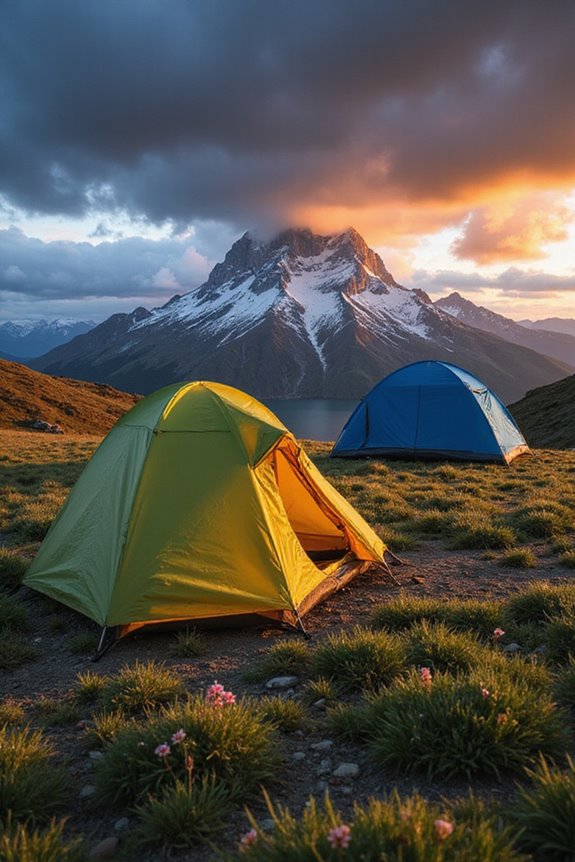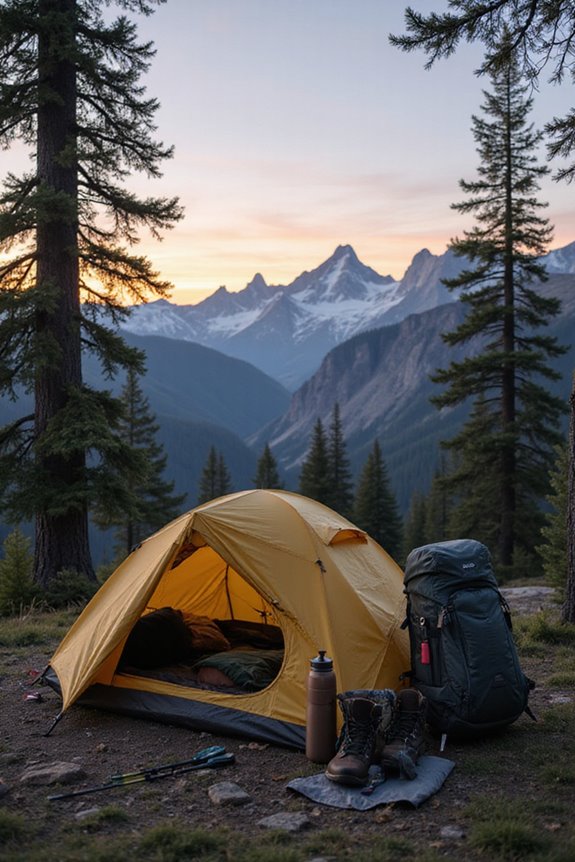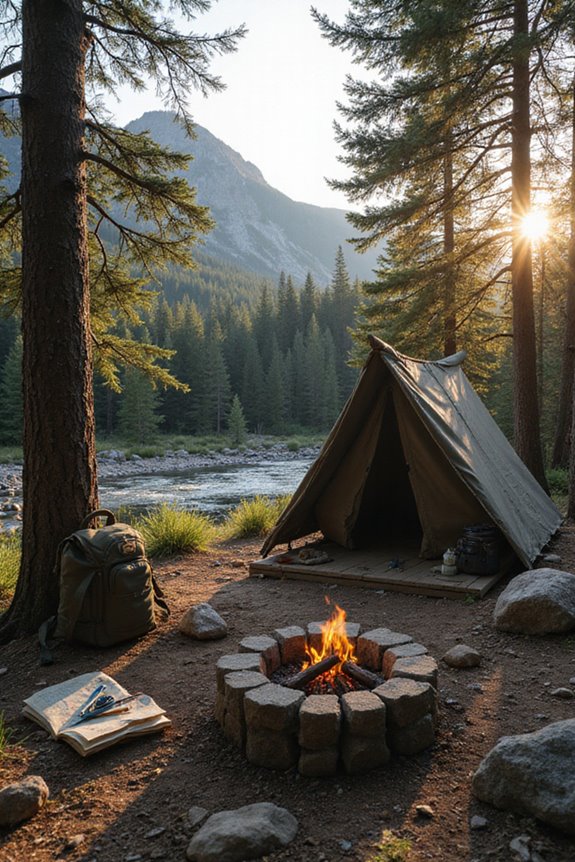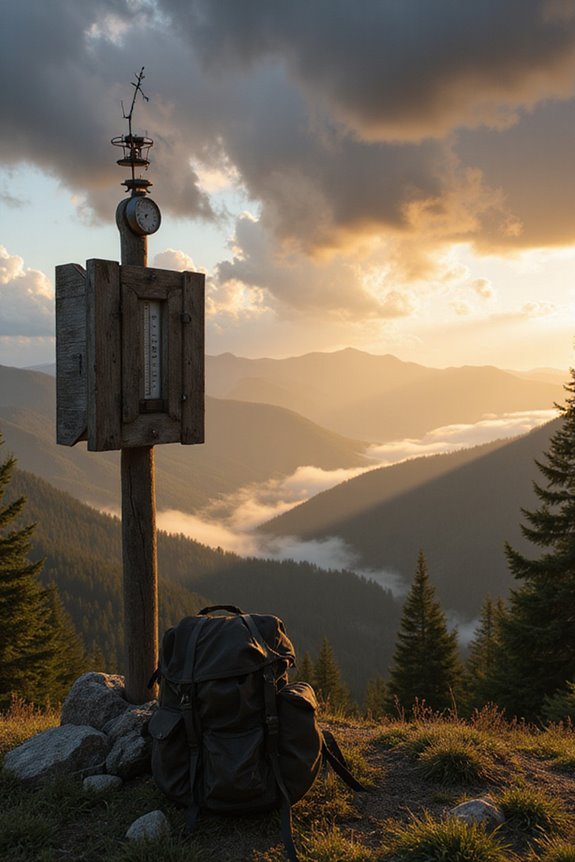Choosing a tent for different weather can feel like a maze, but it doesn’t have to be. For summer camping, I love lightweight 3-season tents with mesh panels for airflow. When it gets chillier, I opt for extended-season tents; they’re cozy without the bulk of winter tents. And if I’m facing heavy rain or snow, 4-season tents are my go-to—sturdy and built to last. Stick around, and I’ll share even more tips for your next adventure!
Key Takeaways
- Select a 3-season tent for moderate weather, ideal for spring through fall camping with lightweight materials and good ventilation.
- Consider an extended-season tent for unpredictable weather, offering added stability and insulation for early spring and late fall adventures.
- Opt for a 4-season tent when facing harsh winter conditions, featuring thicker fabrics and strong poles for maximum durability and warmth.
- Prioritize ventilation based on the season; summer tents need large mesh panels, while winter tents require adjustable vents to manage humidity.
- Always assess weather resistance features to ensure your tent can withstand expected environmental challenges, preventing camping disasters.
Understanding Tent Seasonality
When I first started camping, I quickly learned that choosing the right tent for the season can make or break your outdoor adventure. I remember my first spring trip, excitedly pitching a lightweight, 3-season tent. The tent materials felt just right, offering enough ventilation to keep me cool but protecting me from unexpected rain. Seasonal camping can be tricky; a tent that’s great for summer might not hold up in autumn’s chill. I’ve learned that 3-season tents are perfect for moderate weather, while extended-season models are better for those unpredictable early springs or late falls. Knowing the nuances of tent seasonality not only keeps you dry, but also turns a potential camping disaster into a memorable adventure under the stars! Additionally, selecting a tent with weather resistance features can significantly enhance your experience by ensuring protection against the elements.
Features of 3-Season Tents
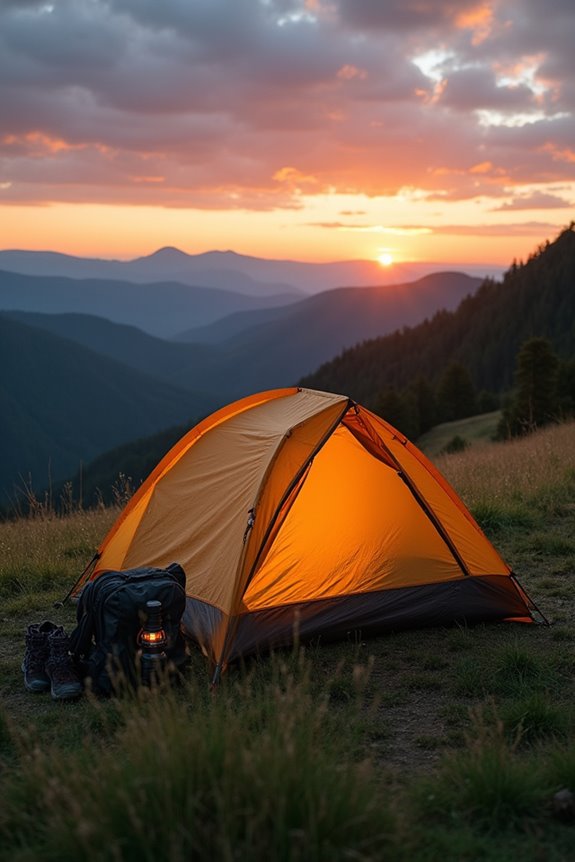
Choosing the right 3-season tent can feel like picking the perfect outfit for a date—it’s all about balancing comfort, style, and functionality. When I look for a tent, I consider lightweight tent materials like ripstop nylon, which keeps things easy to carry on those long hikes. I love the seasonal features, like the extensive mesh panels that let the breeze in while keeping pesky bugs out. Plus, with dual doors and vents, I can stay cool during warm nights. And let’s not forget, these tents are designed to handle moderate rain and wind, so I can camp confidently in spring through fall. After all, a little drizzle shouldn’t ruin my adventure!
Characteristics of Extended-Season (3+ Season) Tents

As someone who loves to hit the trails year-round, I can tell you that extended-season tents are a game changer. These tents provide incredible extended season benefits, thanks to their added pole strength and sturdy designs. With extra poles, they can handle unexpected snow and wind like a champ. The fabric composition also shines, using fewer mesh panels and thicker materials for better insulation while still allowing some ventilation. I love how they balance warmth and breathability, perfect for those chilly spring or fall nights! Plus, they’re still manageable for backpacking trips. If you want versatility without the bulk of a full-on winter tent, an extended-season tent is a fantastic choice for any outdoor enthusiast.
Design and Performance of 4-Season Tents

Envision this: you’re nestled in a cozy four-season tent while snowflakes swirl outside like tiny, fluffy ninjas trying to sneak in. The design durability of these tents is impressive—they’re built with thicker fabrics that laugh in the face of harsh weather. With double-wall construction, I’ve found that they keep me warm while the waterproof flysheet shields me from moisture. The poles? They’re stronger than my resolve to stay warm, crafted from heavy-duty materials to resist bending. Plus, the clever dome shape and extra guylines mean my tent stands tall against fierce winds. All these thoughtful features guarantee I’m not just camping; I’m comfortably weatherproof, ready to embrace the wild, no matter what Mother Nature throws my way.
Tent Structure and Wind Resistance
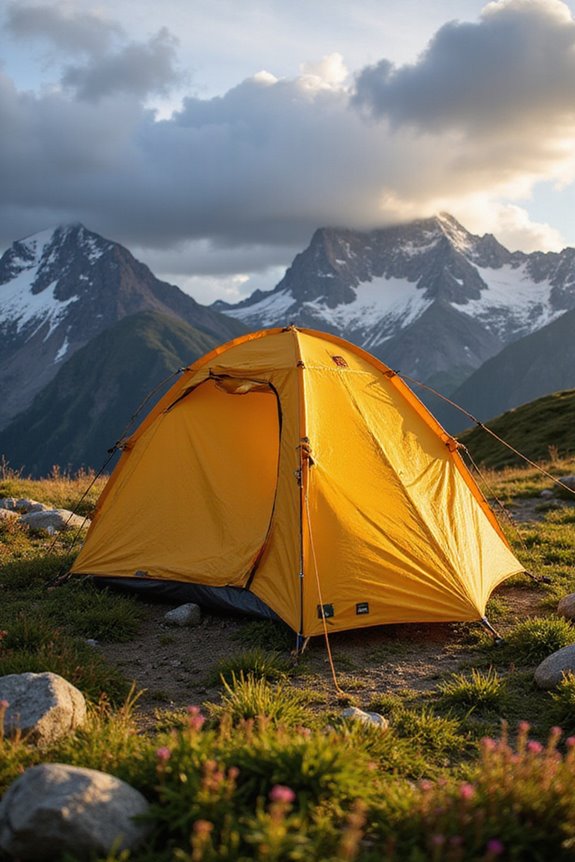
When you’re out in the wild, the last thing you want is for your tent to become a kite on a windy day, right? So, let’s talk tent aerodynamics! Choosing a low-profile tent with gently sloping panels can really help minimize wind drag. I’ve found that pyramid and triangulated shapes offer solid wind resistance, thanks to their compact forms. The pole stability is essential, too—multi-pole systems spread out tension, making the tent more resilient against gusts. Plus, materials like lightweight nylon can absorb wind loads without losing strength. Remember to position your tent edge-on to the wind. It makes a world of difference! Trust me, a well-structured tent can mean the difference between a peaceful night and an unexpected adventure!
Ventilation Considerations by Season
Ventilation can make or break your camping experience, especially as the seasons change. In summer, I can’t stress enough how important summer ventilation is—those hot nights are brutal! I love tents with large mesh panels and removable sidewalls; they keep the air flowing while keeping pesky bugs out. As fall rolls in, I look for tents that balance airflow and warmth to fend off chills. Adjustable vents become my best friends! In winter, I crave that winter warmth, so I opt for 4-season tents with multiple vents. They let me control humidity while staying cozy. Each season demands thoughtful adjustments, but getting it right makes every camping trip a dream—just don’t forget the hot cocoa for those chilly nights!
Additional Factors for Weather-Appropriate Tent Selection
Picking the right tent isn’t just about the size or color; it’s also about how well it stands up to the wild weather Mother Nature can throw at us. I’ve learned that weather-resistant fabrics, like industrial-strength polyester, are a game-changer, especially during a surprise downpour. And don’t forget about tent accessories—like a solid rainfly or extra guy lines—that can enhance stability and keep you dry. Maintenance tips are key, too! Regularly check for wear and tear, and always have a repair kit handy. Trust me, it’s no fun patching up a leaky tent in the rain. With these considerations, you’ll be ready to face whatever the weather throws your way, keeping your camping experience enjoyable!
Making the Right Choice for Your Trip
Choosing the right tent for your trip can feel a bit overwhelming, especially with so many options out there. I remember my first camping trip—so excited, yet clueless about tent size and footprint! It’s essential to think about your group size; cramming in too many people can feel like a game of sardines. A little extra space is a lifesaver for gear and comfort, trust me! For longer trips, I’ve found that durable materials and good ventilation make all the difference. And don’t forget to check that tent footprint; it needs to fit your campsite just right. Whether it’s a cozy two-person or a spacious four-person, selecting wisely can turn your adventure into a memorable experience!
Frequently Asked Questions
What Is the Best Tent for Family Camping Trips?
When I consider the best family tent types for camping trips, I look for spaciousness, easy setup, and durability. Investing in solid camping gear essentials, like the North Face Wawona 6, makes all the difference.
How Do I Maintain My Tent for Longevity?
Maintaining my tent feels like guarding a treasure! I always prioritize tent cleaning and use effective waterproofing techniques. Regular inspections and proper storage keep it in top shape for countless adventures under the stars.
Can I Use a 3-Season Tent in Winter?
Yes, I’ve used a 3-season tent for winter camping. While it lacks adequate tent insulation, it can work below treeline with proper gear and modifications. Just make sure to monitor snow loads and wind conditions!
What Is the Average Lifespan of a Tent?
A tent’s lifespan varies, like day and night. High-quality materials last 10-15 years, while poor choices fade quickly. With diligent maintenance, I’ve seen tents thrive far beyond their expected life. It’s all about care!
How Do I Choose a Tent Size for My Group?
When I choose a tent size, I consider the tent capacity and group dynamics. It’s essential to allow extra space for comfort and gear, ensuring everyone can move around without feeling cramped.

